#Chinese village fashion
Explore tagged Tumblr posts
Text
A Chinese woman made a wedding dress from 40 bags of cement :D
Lilia Tang, Weaving Dreams with Unconventional Dresses in Rural China Meet the extraordinary Lilia Tang, a young woman from a quaint Chinese village, whose hands transform unconventional materials into breathtaking dresses. Working alongside her parents in a village where daily life revolves around fields and farms, Lilia stands out for her artistic pursuits. Recently, she garnered widespread…
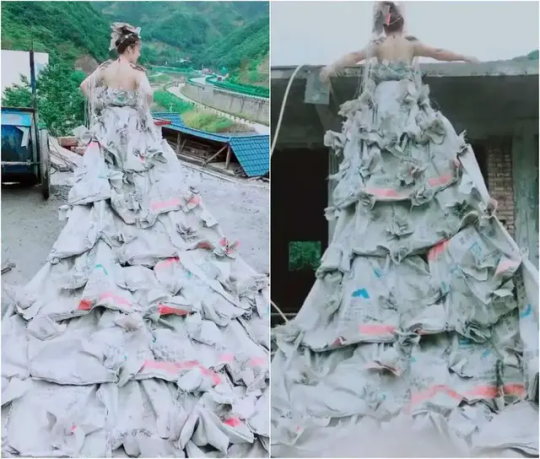
View On WordPress
#Breathtaking dresses from unexpected materials#Cement Bag wedding dresses#Chinese village fashion#Handmade wedding dresses#unique wedding dress creations
0 notes
Text

















Hong-Kong 2010, Pt 2
#street photography#china#street style#hong kong#chinese fashion#village#chinese drama#chinese actor#food history#mandarin#chinese actress#cantonese#chinese language
4 notes
·
View notes
Text
my headcanons come in two flavors of "just making shit up". First option is "okay so I took a very specific line and reread the manga with Confirmation Bias Eyes and I can construct a thematically sound but not really textually existing series of events within the story" and the second option is "wghat if they were half Chinese. What then"
#Okay so Suguru is in both of these-#I get so antsy Abt hc characters as Chinese for no discernable reason. But also getting decent Chinese characters in manga#Seems akin to pulling fucking teeth. Tell me why the hell the woman doing unethical surgery in Helter Skelter had a Chinese mom#Also Yuki's top is clearly Chinese style so. Um. What if there was Chinese People also.#Nanako and Mimiko are also mixed Chinese imo and that's part of why the villagers hated them + their parents. Old fashioned racism#...also regarding mixed HCs I headcanon Shoko as being Iraqi. Just cause
0 notes
Text

Isabel, 22
“I am wearing a self made dress that creates the Chinese character “love” from the ruffles. On top is a tweed blazer from pushButton, and below are pants from Damaskeen. I feel like my style is very much dependent on the occasion of the day. I like to wear pieces that are comfortable but have eye-catching elements, I love it when fashion generates conversation.”
May 15, 2024 ∙ Greenwich Village
282 notes
·
View notes
Note
Even more thoughts, for you to post if you so choose!
I do love the idea of Shen Yuan having a fancy hair piece with a pin that doubles as a weapon! Just because demon crows don’t have access to spiritual swords doesn’t mean he can’t stab the hell out of you.
For his main weapon, I’m thinking crow demons that can take human form tend to use bows, with the feathers shed by their clan as fletching. (Perhaps demon feathers also grant abilities of some sort to the arrows?)
Looking at the iridescence of crow feathers reminds me of the Chinese tradition of making jewelry with kingfisher feathers. Now I think it would be lovely if the crow demons also had a tradition of fashioning similar jewelry with their own feathers, perhaps treated with solutions and lacquered in a way that brings out even more of their color.
Speaking of colors, while crows aren’t among those birds able to see significant ultraviolet, they are tetrachromats, and thus are able to distinguish colors to a far greater extent than humans. I’m sure his sudden ability to see way more colors than he could in his last life is very perplexing to poor Shen Yuan!
The regular crows acting as an alarm system by cursing and saying spooky nonsense at all unknown visitors is an absolute delight!
I vote that Shen Yuan intentionally never gives them whatever signal that would mark Airplane as a friend, just so they continue to harass the guy every time he comes to visit. 😂
(I’m thinking poor Airplane is trying to set up trade routes for demons, and struggling with the general hostility different types of demons have for one another. Killing interlopers and/or raiding other demons for their stuff is not conductive to trade! It’s no wonder demons lack the arts. Nobody shares anything with anyone, except when giving demon nobles tribute. 😭)
You know, with all the feathers and bird-folks about, the transmigrators probably figure out quill pens. Not sure how big of an improvement they’d be compared to brushes, but they’re at least more like what the transmigrators are used to.
It’d also be funny if all the demon crows and villagers were learning to write simplified Chinese from Shen Yuan, instead of traditional, leading visitors to wonder what the hell is up with this one location’s weird writing system, where half the characters are inexplicably different.
(He probably teaches them traditional too, if only for the sake of reading imported books and things, but simplified is probably faster for personal notes and bookkeeping or the like).
I've always loved when people have weapons in discreet places, so it seemed necessary to dump that onto Shen Yuan because he's the most iconic character ever. Especially CrowYuan as well, it seems like something he'd do just to be safe when it comes to these things - after everything he's read, it's hard not to always be prepared. (Also, a more cheeky reason if I may, imagine Shen Yuan in a sticky situation and he pulls the hair pin out of his hair, now holding a weapon and looking AWESOME as he does it) Also, main weapon as a bow IS MAKING ME LOOOSE MY MIND. Ever since I was little, I've been obsessed with people who use bows (Legolas, Robin Hood, Hawkeye, Kate Bishop, various book characters) and the idea of giving Shen Yuan a bow?? I am dropping to my knees and shaking my fists at the sky. HUZZAAAHH!!! Feathers as fletching is a great idea, almost like a calling card of sorts, as well as a warning. Demon feathers giving certain abilities to arrows is a brilliant idea, such as resilience, poison, increased speeds (useful for high pressure situations where someone has to die before they can be alerted). I'd find it interesting if different demon feathers grant different abilities, and it's almost a norm for these demons to trade feathers! The jewellery idea is absolutely gorgeous and adorable! I was thinking that it could mainly be a crow demon thing, and to have one made for you if you aren't a crow demon is a sign of great trust within the community, a decision that has to be agreed to by at least half of the community! Also, itty bitty angst idea, this jewellery could also be highly sought out because it's gorgeous and its making is entirely a clan secret that is only taught to those within it - so, it's often seen as a spoil of war, a way to brag about a crow demon's death is to wear the jewellery "won" from "battle". Shen Yuan would most definitely be thrown off guard by this wider arrange of colours, often found in the wildest areas of the forest and just staring at everything. At first, he wonders if it's because he's a demon now, but more research (aka, bullying a demon chicken Airplane for answers) shows that it is fact not because he's a demon, but instead because he's a crow. He is both excited that he can see all these colours and fiercely delighted that Airplane can't, because he's a spiteful little shit and I love him. If Airplane comes to visit, he's grown adept to immediately submitting to the harassment of the crows because they soon grow bored of him if they don't get any reaction other than pitiful screaming. (He would highly suffer from trying to set up trade routes as well, lmaooo) OH MY GOD, if Mobei Jun ever comes to visit Bing-ge, he would also be immediately attacked by crows and that is funnier than anything else right now in my mind. His stern face immediately becomes one of absolute outrage, but it quickly becomes confusion when Bing-ge says he can't attack them back because "Shen Yuan would never forgive me" On the idea of feathers as quill pens, that would end up being incredibly useful for them! Perhaps the use of certain demon feathers would be better than others if we go by different demon feathers holding different abilities - for instance, let's say crow feathers hold increased speed, that would be helpful for writing because one would merely need to guide the quill and let it do the rest. However, a demon feather that created a poison effect, let's say chicken feathers, would not be the best for writing, which makes certain feathers more valuable than others for different things! Shen Yuan would be a great teacher, because he knows the traditional Chinese - which is useful for things you previously mentioned - but then he would be able to introduce a whole new writing system that makes it easier to write. This would be especially useful for those who may struggle with the traditional Chinese, because then they would still be able to access writing!! {part seven! part one, part two, part three, part four, part five, and part six!}
#four answers asks#crowyuan au#at least I don't have summer work anymore#scum villian self saving system#scum villain#svsss#svsss au#shen yuan#luo bingge#bingge#binggeyuan
272 notes
·
View notes
Text
[Hanfu · 漢服]Chinese Late Warring States period(475–221 BC) Traditional Clothing Hanfu Based On Based On Chu (state)Historical Artifacts
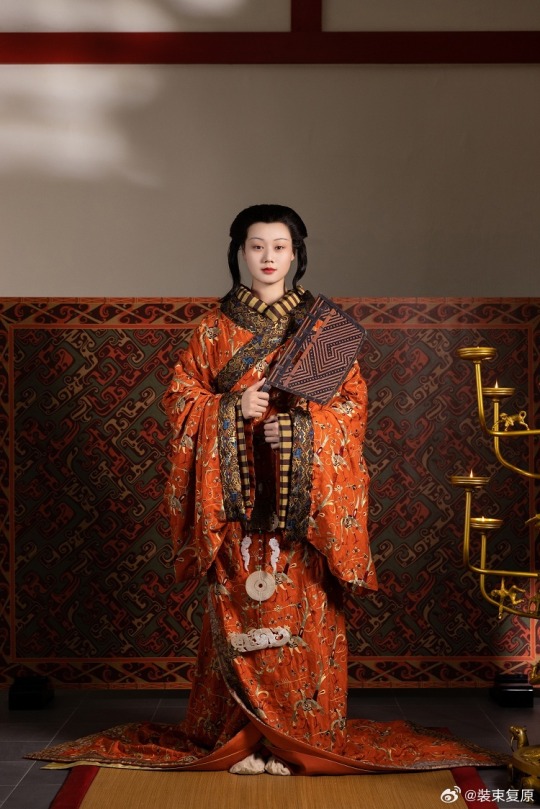
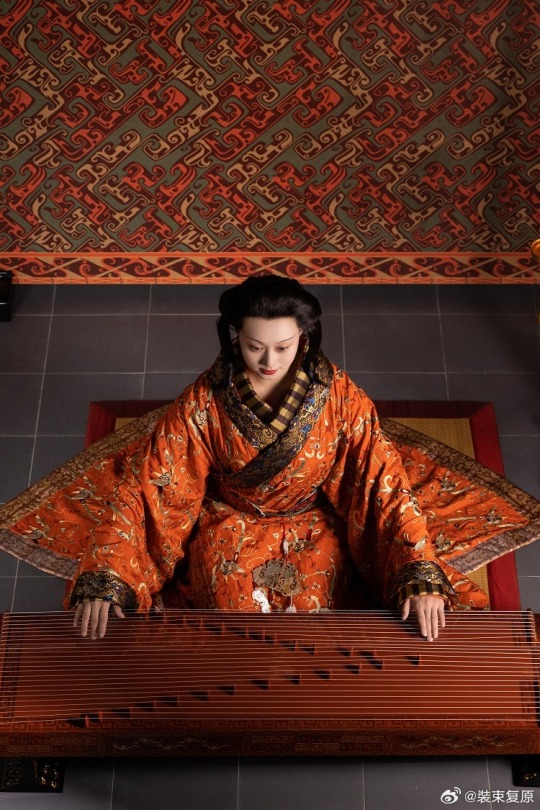
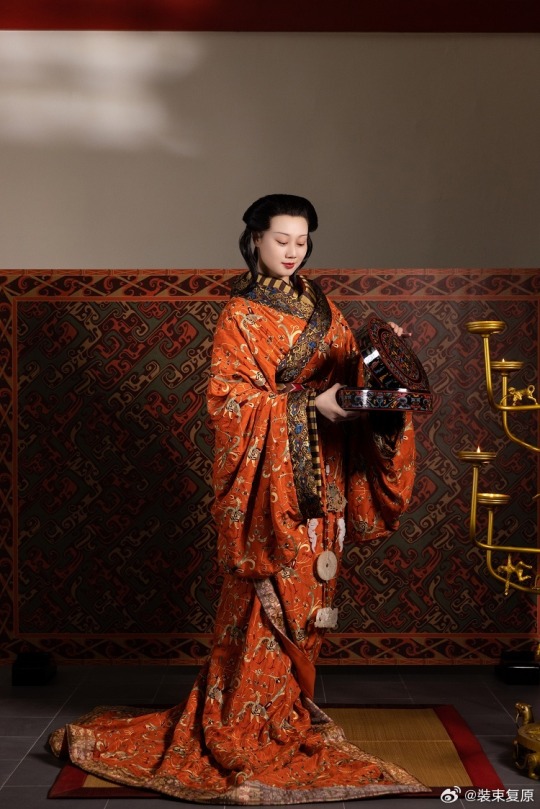
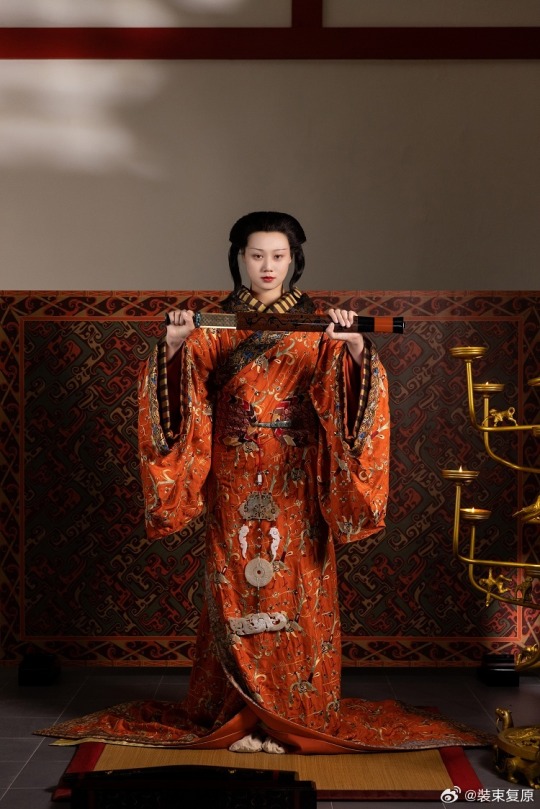

【Historical Artifact Reference】:
Late Warring States period(475–221 BC):Two conjoined jade dancers unearthed from Jincun, Luoyang,collected by Freer Museum of Art

A similar jade dancer was also unearthed from the tomb of Haihunhou, the richest royal family member in the Han Dynasty, and was one of his treasures.
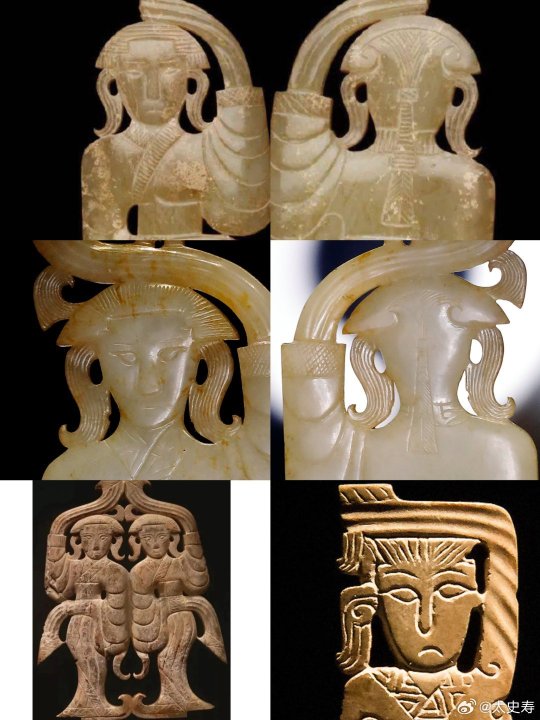
Warring States period, Eastern Zhou dynasty, 475-221 BCE,jade dancer by Freer Gallery of Art Collection.
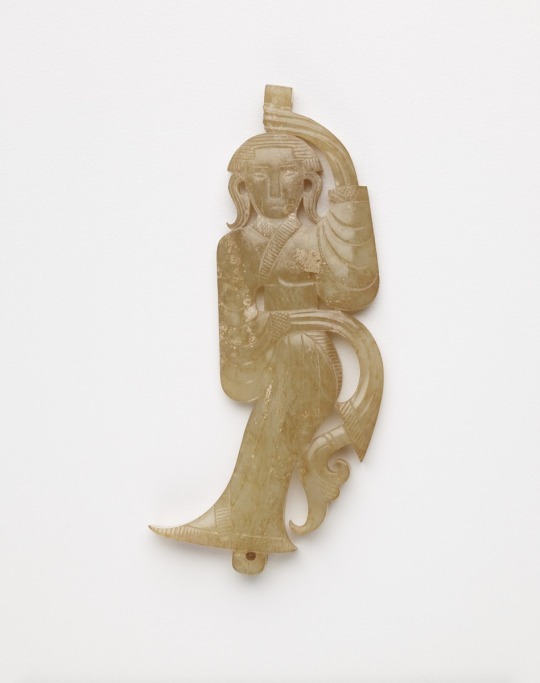
Warring States period(475–221 BC)·Silver Head Figurine Bronze Lamp.Unearthed from the Wangcuo Tomb in Zhongshan state during the Warring States Period and collected by the Hebei Provincial Institute of Cultural Relics and Archaeology
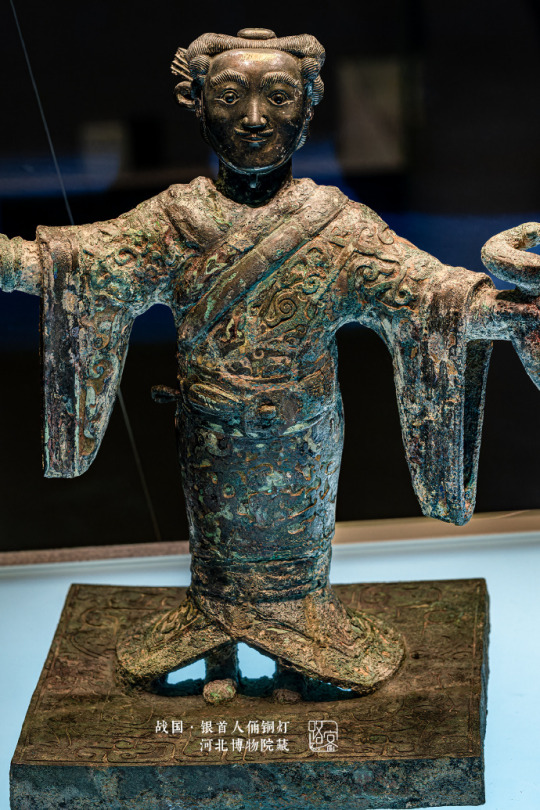


The figurine of a man dressed as a woman holds a snake in his hand, and 3 snakes correspond to 3 lamps.
Sword of Goujian/越王勾践剑:
The Sword of Goujian (Chinese: 越王勾践剑; pinyin: Yuèwáng Gōujiàn jiàn) is a tin bronze sword, renowned for its unusual sharpness, intricate design and resistance to tarnish rarely seen in artifacts of similar age. The sword is generally attributed to Goujian, one of the last kings of Yue during the Spring and Autumn period.
In 1965, the sword was found in an ancient tomb in Hubei. It is currently in the possession of the Hubei Provincial Museum.

【Histoty Note】Late Warring States Period·Noble Women Fashion
The attire of noblewomen in the late Warring States period, as reconstructed in this collection, is based on a comprehensive examination of garments and textiles unearthed from the Chu Tomb No. 1 at Mashan, Jiangling, as well as other artifacts from the same period.
During the late Warring States period, both noble men and women favored wearing robes that were connected from top to bottom. These garments were predominantly made of gauze, silk, brocade, and satin, with silk edging. From the Chu Tomb No. 1 at Mashan, there were discoveries of robes entirely embroidered or embroidered fragments. The embroidery technique employed was known as "locked stitches," which gave the patterns a three-dimensional, lively appearance, rich in decoration.
The two reconstructed robes in this collection consist of an inner robe made of plain silk with striped silk edging, and an outer robe made of brocade, embroidered with phoenixes and floral patterns, with embroidered satin edging. Following the structural design of clothing found in the Mashan Chu Tomb, rectangular fabric pieces were inserted at the junction of the main body, sleeves, and lower garment of the robe. Additionally, an overlap was made at the front of the main body and the lower garment to enlarge the internal space for better wrapping around the body curves. Furthermore, the waistline of the lower garment was not horizontal but inclined upward at an angle, allowing the lower hem to naturally overlap, forming an "enter" shape, facilitating movement.
The layered edging of the collars and sleeves of both inner and outer robes creates a sense of rhythm, with the two types of brocade patterns complementing each other, resulting in a harmonious effect. Apart from the robes, a wide brocade belt was worn around the waist, fastened with jade buckle hooks, and adorned with jade pendants, presenting an elegant and noble figure.
The reconstructed hairstyle draws inspiration from artifacts such as the jade dancer from the late Warring States period unearthed at the Marquis of Haihun Tomb in Nanchang, and the jade dancer from the Warring States period unearthed at Jin Village in Luoyang. It features a fan-shaped voluminous hairdo on the crown, with curled hair falling on both sides, and braided hair gathered at the back. The Book of Songs, "Xiao Ya: Duren Shi," vividly depicts the flowing curls of noblewomen during that period. Their images of curly-haired figures in long robes were also depicted in jade artifacts and other relics, becoming emblematic artistic representations.
The maturity and richness of clothing art in the late Warring States period were unparalleled in contemporary world civilizations, far beyond imagination. It witnessed the transition of Chinese civilization into the Middle Ages. The creatively styled garments and intricate fabric patterns from the Warring States period carry the unique essence, mysterious imagination, and ultimate romanticism of that era, serving as an endless source of artistic inspiration.
--------
Recreation Work by : @裝束复原
Weibo 🔗:https://weibo.com/1656910125/O6cUMBa1j
--------
#chinese hanfu#Late Warring States Period#Warring States period(475–221 BC)#hanfu#hanfu accessories#chinese traditional clothing#hanfu_challenge#chinese#china#historical#historical fashion#chinese history#china history#漢服#汉服#中華風#裝束复原
279 notes
·
View notes
Text
April 20, Beijing, China, National Museum of China/中国国家博物馆 (Part 6 – Ancient Chinese Jade exhibition/中国古代玉器展 and part of The Power of Science and Technology exhibition/科技的力量展):
Starting with the Ancient Chinese Jade exhibition today, this is a Qing dynasty (1644 - 1911) Qianlong era (1736 - 1796) jade brush holder. It's impossible to tell from this angle (my bad lol), but the relief on this brush holder actually depicts the Sanxing/三星 (lit. "three stars"), which is the name of a group of three Daoist deities: Fuxing/福星 (lit. "Fortune Star"; Jupiter), Luxing/禄星 (lit. "Prosperity Star"; Mizar of Ursa Major), and Shouxing/寿星 (lit. "Longevity Star"; Canopus). These three gods are frequently depicted together for auspiciousness.

A Qing dynasty Qianlong era jade gaiwan/盖碗 (lit. "lidded bowl"), decorated with gold inscription of Qianlong Emperor's poetry and plum blossoms. Gaiwan are a specific type of Chinese tea cup that can be used to both infuse tea and drink tea, and may consist of three parts--a bowl, a lid, and a saucer. Because of this three-part structure, it's also called sancaiwan/三才碗, where the lid, bowl and saucer correspond to "heaven", "human", and "earth" respectively. Alternatively gaiwan can be more literal like the one here, which only has a bowl and a lid. Some say the gaiwan originated in Sichuan in Tang dynasty (618 - 907 AD), but evidence suggests that true gaiwan (with lid) only appeared in late Ming dynasty to early Qing dynasty (around 16th-17th century). Gaiwan was very popular in Qing dynasty and remains popular today.

Left: Ming dynasty (1368 - 1644) diancui/点翠 and jade ornament, with egrets and lotuses carved into the jade part. As mentioned before in the second historical fashion exhibition post, diancui (the blue parts) is a method of decoration that uses the iridescent feathers of kingfishers. Because all species of kingfishers are now protected by law, all diancui on the market currently are imitations.
Right: Ming dynasty wooden table screen with carved jade insert depicting a dragon. This is pretty cute tbh considering how small it is

Qing dynasty jade decor called a shanzi/山子, with a visual depiction of the chengyu 老马识途 ("old horses know the path") carved into the jade. Shanzi pieces are characterized by their retainment of the original shape of the jade, and depictions of scenes and stories within the jade with methods including reliefs, full reliefs, and openwork sculpting.

Left: Jin dynasty to Yuan dynasty (1115 - 1368) jade ornament depicting chrysanthemum flowers.
Middle left: a Ming dynasty copper daikua/带銙 (basically belt decoration) inlaid with carved jade depicting deer and pines.
Middle right: a Qing dynasty jade pendant in the shape of two badgers.
Right: Qing dynasty jadeite daigou/带钩 (basically belt buckle) with fish and bat motifs. In traditional Chinese symbolism, fish symbolizes "surplus" (鱼 is a homophone of 余), and bats symbolize "fortune" (蝠 is a homophone of 福).
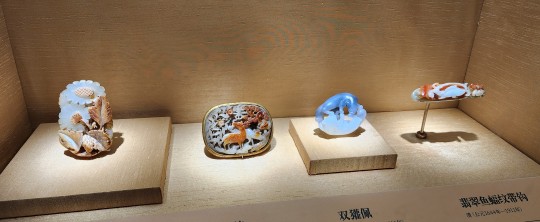
Notice how each of the above pieces utilize the colors inherent in the jade itself to lend color to the subject depicted. This method is still widely used today in modern jade/stone sculpting, and sometimes the finished piece can be stunning. Here's a modern example that's not from this exhibition: the piece 山乡晨曦 ("Mountain Village in Dawn's Light") by 黄日富. This entire scene is fashioned from a single stone.
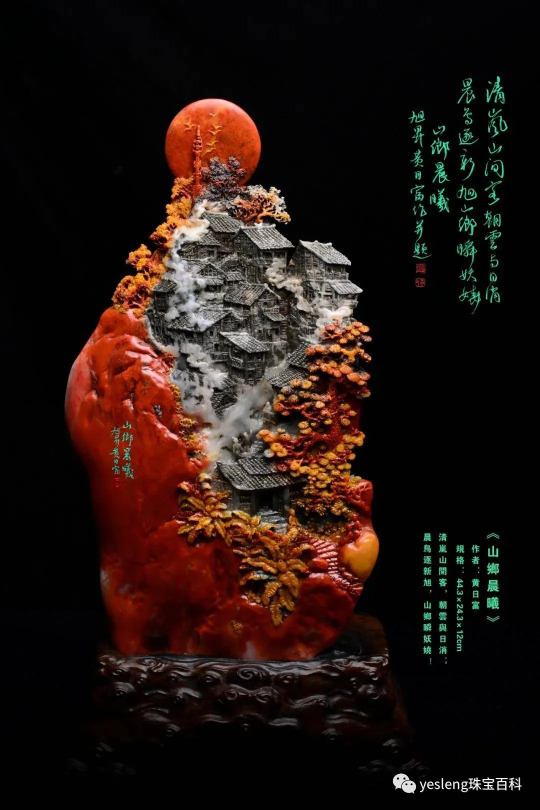
And back to the exhibition, I forgot to take pictures of the placards for the next two artifacts, and the museum's complete online catalogue doesn't have a search function (UGH)......so I'll put my best guess here, but don't take my word for it lol
A jade decor depicting a dragon, probably from either Ming or Qing dynasty:
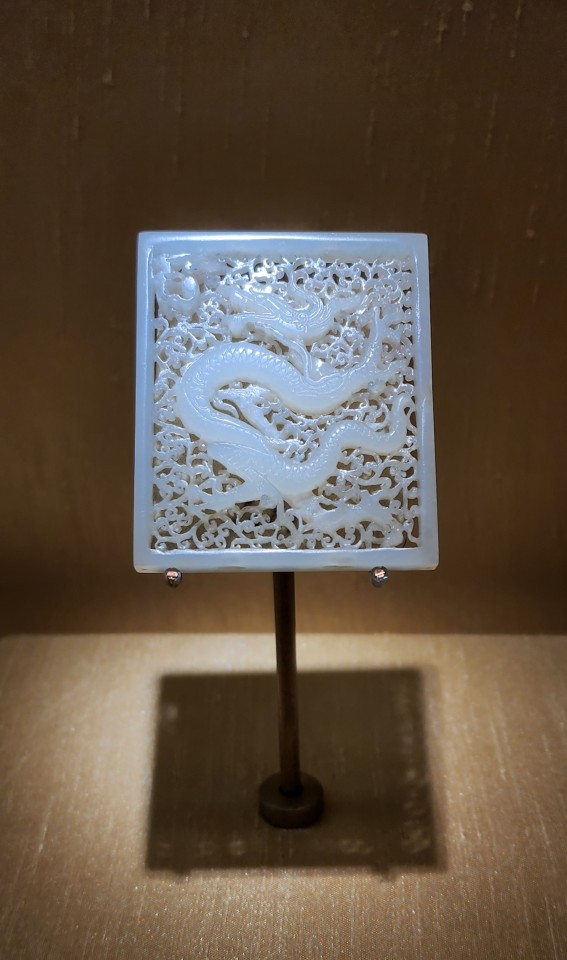
This seems to be a jade jianzhi/剑璏, no idea what time period it's from. Jianzhi are basically flat belt loops attached to the sheath of the jian sword scabbard, so that the jian sword may be carried on its owner's belt.

And onto The Power of Science and Technology exhibition. The pictures I'm sharing here will be primarily focused on ancient Chinese science and technology.
Ink rubbing of the famous Southern Song dynasty (1127 - 1279) star chart stele (called 天文图碑 in Chinese), showing the positions of the Chinese constellations. This star chart was drawn by Southern Song dynasty astronomer Huang Shang/黄裳 based on observations made between 1078 and 1085 (during Northern Song dynasty), and the stele was erected in 1247. The stele itself still stands in the Confucian Temple in Suzhou, China. Here's a link if anyone wants to see a clearer image of the rubbing (to avoid confusion: the rubbing in this webpage was made in Qing dynasty, but the stele was erected in 1247).

Chart of the Twenty-Eight Mansions/二十八宿 from the Ming dynasty illustrated encyclopedia Sancai Tuhui/三才图会, Volume 1. The Twenty-Eight Mansions are regions around the ecliptic used to identify the location of the Sun, Moon, Venus, Jupiter, Mercury, Mars and Saturn. This is an important concept for both traditional Chinese astrology and astronomy.

Top left: ancient observation of a solar eclipse documented in the Book of Documents/《尚书》.
Top right: ancient observation of Halley's Comet in fall of 613 BC documented in Spring and Autumn Annals/《春秋》. Apparently Chinese historical records never missed a single observation of the return of Halley's Comet from 240 BC to 1986, which is pretty amazing (note: this author may have made a mistake regarding the year of the observation recorded in Spring and Autumn Annals).
Bottom left: ancient observation of a nova documented in Book of Han/《汉书》 (completed in 111 AD).
Bottom right: ancient observation of a sunspot documented in Book of Han.

If one flips through any of the 24 official histories of China (二十四史), one will find these records of historical events peppered with observations of astronomical phenomena. This is because of the traditional Chinese astrology concept known as "interactions between heaven and mankind" (天人感应), where it's believed that whatever happens in the heavens will be reflected in the mortal realm in some way, and vice versa. Because of this indistinction between astronomy and astrology, the vast majority of Chinese dynasties would have an imperial bureau set up just to observe, record, calculate, and interpret the movement of celestial bodies and astronomical phenomena, since these were viewed as reflections of the state and fate of the entire country. In reality however, this bureau often functioned as a special panel of political advisors to the emperor. This bureau is referred to by different names throughout Chinese history, but the two most well known names are 司天监 and 钦天监.
A representation of a piece of ox scapula oracle bone from Shang dynasty (~1600 - 1046 BC; original artifact is in this museum) inscribed with terms from the Sexagenary Cycle, called Heavenly Stems and Earthly Branches (tiangandizhi/天干地支) in Chinese, or Stems and Branches (ganzhi/干支) for short. This cyclical system of 60 terms is used to record the year, month, day, and hour in traditional Chinese calendar (for example right now is still the year 甲辰, but after Chinese New Year, it will be the year 乙巳); however, in Shang dynasty, this system was only used to record days. The Sexagenary Cycle is still used by traditional Chinese painters and calligraphers when dating their works.
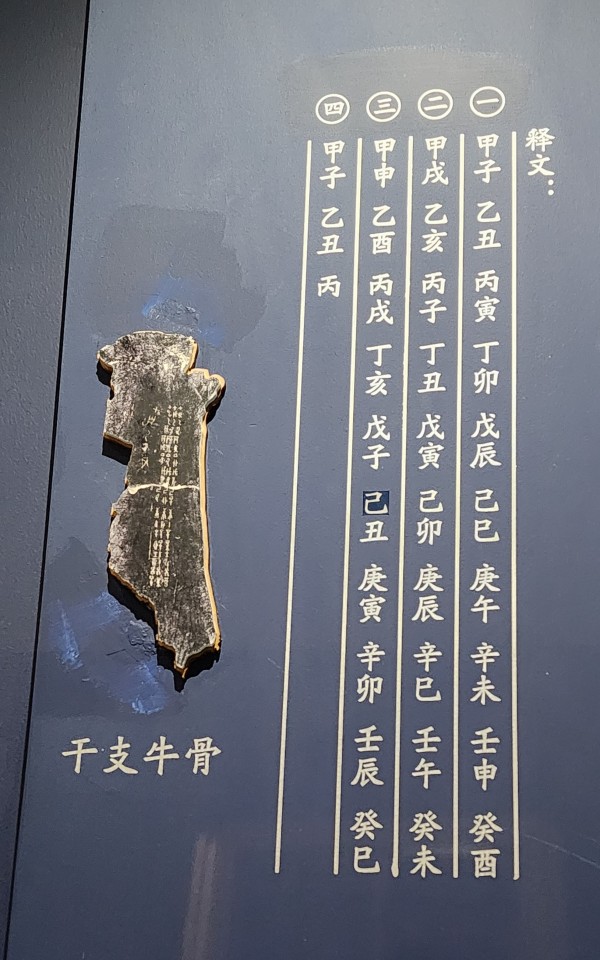
Four of the calendars used in different time periods in Chinese history, the Taichu Calendar/太初历 of Han dynasty (top left), created in 104 BC; the Daming Calendar/大明历 of Southern dynasty (top right), created in 462 AD; the Dayan Calendar/大衍历 of Tang dynasty (bottom left), created in 729 AD; and the Shoushi Calendar/授时历 of Yuan dynasty (bottom right), created in 1281. All of these are lunisolar calendars.

The Northern Song dynasty (960 - 1127) official military compendium Complete Essentials for the Military Classics/《武经总要》, by Zeng Gongliang/曾公亮 and Ding Du/丁度. The version seen here is the version included in the Qing dynasty book collection Complete Library of the Four Treasures/《四库全书》, completed in 1782.
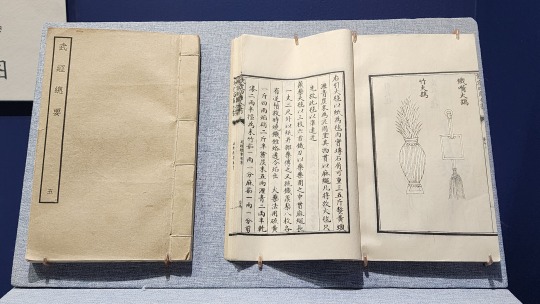
And the book that has appeared a couple times throughout this series of posts already, the Ming dynasty illustrated encyclopedia Sancai Tuhui/《三才图会》:
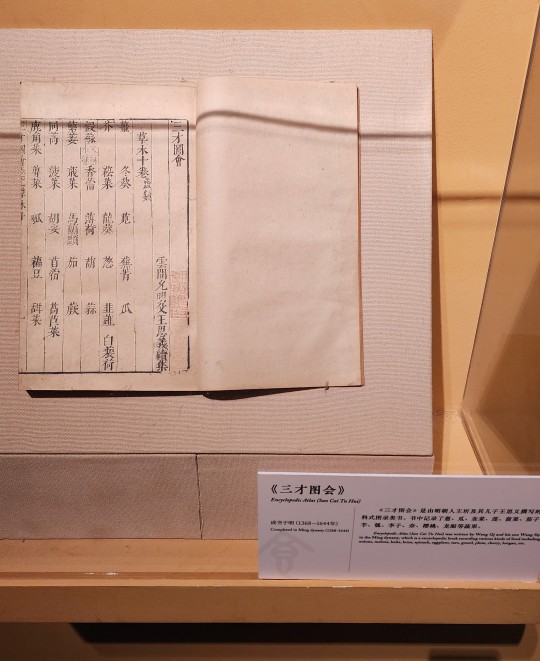
This is the Ming-era Chinese translation of the mathematical work The Elements by Euclid, titled 《几何原本》. The translators were the Jesuit missionary Matteo Ricci and Xu Guangqi/徐光启 (there's more information on the placard).
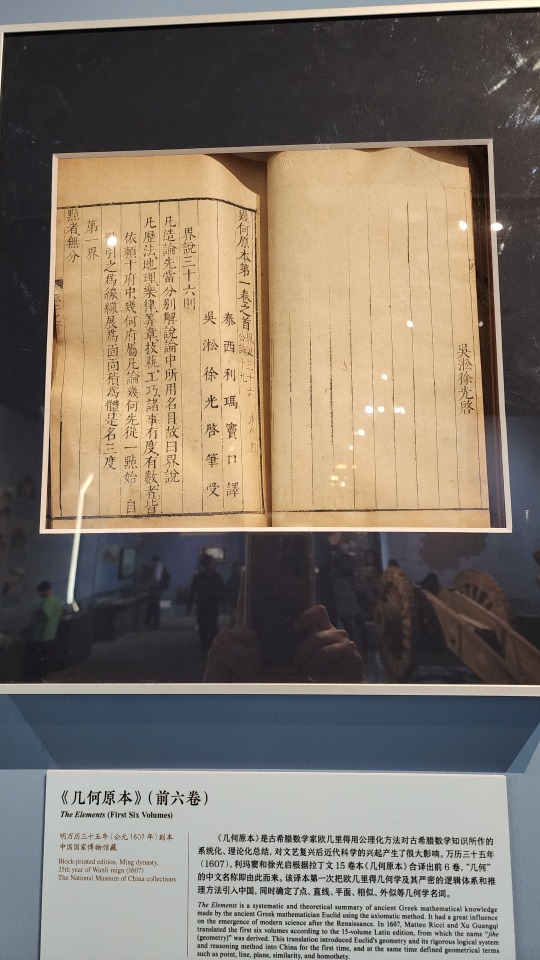
Here is one of the ways in which ancient Chinese science and technology still contributes to the world today, a lesser known example than the famous Four Inventions: the discovery of the antimalarial drug artemisinin (named qinghaosu/青蒿素 in Chinese) by Chinese chemist Tu Youyou/屠呦呦 in the 1970s. Artemisinin is derived from the plant Artemisia annua L., which was recorded in The Handbook of Prescriptions for Emergency Treatments/《肘后备急方》, a book on traditional Chinese medicine written by Ge Hong/葛洪 in 340 AD, as effective against malaria. Since its discovery, artemisinin and its derivatives have saved millions of people, and are now recommended by the WHO as part of the frontline therapy for malaria. For her discovery of artemisinin, Tu Youyou was awarded the Nobel Prize in Medicine in 2015. On display here are Tu Youyou's letter to the Chinese plant biologist Qian Yingqian/钱迎倩, and her revisions to the draft of Discovery and Development of New Antimalarial Drug Qinghaosu (Artemisinin).

For thousands of years, Chinese people gazed at the stars in awe and wonder what messages the heavens wished to convey. Today, with modern science and technology, the heavens are not so mysterious and out-of-reach anymore, and people can appreciate the universe simply for its vast beauty. In 2013 China sent its first lunar rover, Yutu/玉兔, to the moon. In 2020, Chang'e 5/嫦娥五号 brought back a sample of lunar soil. The names of Yutu and Chang'e come from the names of the moon rabbit and the moon goddess of traditional Chinese mythology respectively (here's an old post I wrote on Chang'e and the moon rabbit, if anyone's interested in the legend).
Left: 1:1 model of the 2013 Yutu/玉兔 rover. (both pictures from National Museum of China official site; I saw the actual model and the actual sample but didn't take a picture of it)
Right: part of the lunar soil sample that Chang'e 5 brought back in 2020.
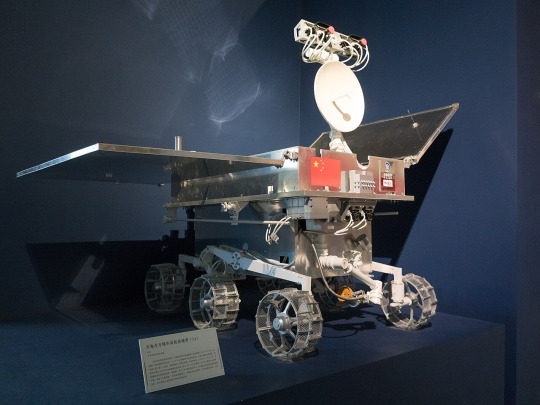
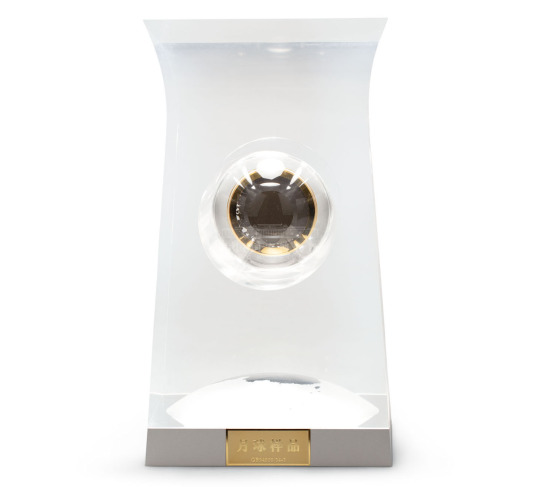
Looking at the lunar soil sample really made me appreciate how far humanity has come, and how much China has developed. I remember witnessing China's first manned spaceflight in 2003, that was just a little over 21 years ago. These are truly exciting times.
Phew. Another post that ended up being way more involved than I initially thought......the next post will be the last one of the museum posts in the 2024 China series, and it will be on the history of tea, wine, and food in China (mmm). It will be posted by the Friday before Chinese New Year. Stay tuned!
#2024 china#beijing#china#national museum of china#jade#jade sculptures#chinese art#chinese astronomy#chinese astrology#chinese calendar#chinese medicine#artemisinin#chinese culture#chinese history#art#culture#history#astronomy#astrology#medicine
90 notes
·
View notes
Text
Those cheap clothes at Shein have a big price tag which few consumers are able to see.
This is the sound of Panyu, the neighbourhood known as the "Shein village", a warren of factories that power the world's largest fast fashion retailer. "If there are 31 days in a month, I will work 31 days," one worker told the BBC. Most said they only have one day off a month. The BBC spent several days here: we visited 10 factories, spoke to four owners and more than 20 workers. We also spent time at labour markets and textile suppliers. We found that the beating heart of this empire is a workforce sitting behind sewing machines for around 75 hours a week in contravention of Chinese labour laws. [ ... ] But even past 22:00, the sewing machines - and the people hunched over them - don't stop as more fabric arrives, in trucks so full that bolts of colour sometimes tumble onto the factory floor. "We usually work, 10, 11 or 12 hours a day," says a 49-year-old woman from Jiangxi unwilling to give her name. "On Sundays we work around three hours less." She is in an alleyway, where a dozen people are huddled around a row of bulletin boards. They are reading the job ads on the board, while examining the stitching on a pair of chinos draped over it. [ ... ] The migrant worker from Jiangxi is looking for a short-term contract - and the chinos are an option. "We earn so little. The cost of living is now so high," she says, adding that she hopes to make enough to send back to her two children who are living with their grandparents. "We get paid per piece," she explains. "It depends how difficult the item is. Something simple like a t-shirt is one-two yuan [less than a dollar] per piece and I can make around a dozen in an hour."
Let's do a little math. One Chinese Yuan = 13.81 US cents (or $0.1381) as of Monday. So if the migrant worker from Jiangxi earns CN¥ 2.00 per t-shirt (US$0.2762) and does a dozen in one hour, she is effectively earning US$3.31 per hour. For comparison, the US minimum wage was US$3.35 per hour in between 01 January 1981 and 01 April 1990.
The working hours at Shein factories are as miserable as the pay. A "standard" working day is 14 hours.
Standard working hours appear to be from 08:00 to well past 22:00, the BBC found. This is consistent with a report from the Swiss advocacy group Public Eye, which was based on interviews with 13 textile workers at factories producing clothes for Shein. They found that a number of staff were working excessive overtime. It noted the basic wage without overtime was 2,400 yuan (£265; $327) - below the 6,512 yuan the Asia Floor Wage Alliance says is needed for a "living wage". But the workers we spoke to managed to earn anywhere between 4,000 and 10,000 yuan a month. "These hours are not unusual, but it's clear that it's illegal and it violates basic human rights," said David Hachfield from the group. "It's an extreme form of exploitation and this needs to be visible." The average working week should not exceed 44 hours, according to Chinese labour laws, which also state that employers should ensure workers have at least one rest day a week.
There are other issues mentioned in the article such as the sourcing of cotton from Xinjiang where the Chinese Communist Party is committing genocide against the Uighur people.
Don't buy clothing made in sweatshops from ANY country. In the US it was sweatshop conditions at clothing manufacturers which were one of the spurs for the growth of labor unions in the early 20th century.
I would add that "fast fashion" is generally wasteful and bad for the environment. Buy clothes which are not likely to quickly become unfashionable and those which are sturdy enough to last for a while.
#shein#clothing manufacturers#fast fashion#sweatshops#china#panyu#labor laws#bbc#asia floor wage alliance#a living wage#public eye#xinjiang#中国#快时尚#血汗工厂#番禺区#生活工资#劳动法#新疆#赤納粹
42 notes
·
View notes
Text
Someone in bluesky asked who they were, so I figured I could go over them real quick.

A japanese robot stylized after the myth of yuki onnas, although she's given the job of being the company mascot for a company that sells refrigeration technology and frozen goods (such as Ice Cream) the reality of it is that she's the daughter of the CEO, a kind, strong man who gives off Santa Claus vibes.
Cute, Innocent and somewhat Lonely, Ghosty has a skewed idea of how to make friends by trying to greet people with a hearty "BOO!", but she hardly scares anyone.
In reality, she wants to befriend new people.
She can be found as a major NPC in Make a Good MegaMan Level 3!

An European robot, one of many stage hand technician robots that function as roadies of many different types of concerts across the globe, with Jill's field being hard rock.
Though she's a brash metalhead, she grew fond of music herself and wanted an opportunity to breach into the industry on her own.
Through hard work and determination (and an online video channel where she played covers for a long while) she eventually landed a gig with a music production company, which as it happens wanted someone to play an idol role.
Jill now has to balance her real work and metal head tendencies with the duties of being a bubbly, energetic idol for the public, though she generally doesn't mind playing up the cute (and the public is generally aware of her metal head tendencies since she's really bad at keeping her natural behavior in check) making sure that her secret identity remains private to herself (and her close friends).
She's also an NPC in Make a Good MegaMan Level 3.

A Chinese robot, hailing from a traditional rural village over on the mountainous regions of China. Ignite is from a family of firework crafters and handymen that work to upkeep the village's scarce technological commodities.
Given the main trade of the family is fireworks (which generally only comes up during festivals), Ignite puts her drive and fireworks abilities into learning martial arts of various kinds and work odd-jobs around town (and lately, body guard work) to bring money home.
She fashions herself a hero to the village, however, her egocentric and "believe-my-own-hype" behavior often lands her in situations out of her control or where the event blows right on her face in one way or another.
Still, she refuses to give up, ultimately, she IS good spirited and popular with the people of the village (children specially), just a bit harsh and hard to deal with.

An american robot whose original job and name are only known to him and him alone.
He was originally ownded by a rich tycoon in the gambling industry who was all kinds of shady, but through hard work and more than a few well placed gambles, Casino amassed enough of a fortune to buy out the gambling joint from his old owner. Whoever they were there they haven't been seen ever since.
Casino has since expanded the gambling joint into being a vacation resort complete with hotels and theme parks, running with peak efficiency and valuing style and respect to the clients with utmost importance.
He may have a greedy side, but he tends to find people he wants to place under his wing and protection, creating some sort of family of his own. Even if he himself may grumble about people "not pulling their weight", he's generally a softy of an uncle figure.
There's rumors that he may have upgraded himself, allegedly if his reels ever hit 7-7-7, he may become a "Dandy CasinoMan" with a more elaborate human form, though its rare that this ever happens.

A robot made by an international joint alliance looking to do paleontoligical and biological research across the globe, stylized after cavemen, he's a lot smarter than he lets on.
CaveMan thus dwells on the natural regions of various countries, looking for evidences of the past. Being well equipped with excavation, climbing and foraging technology, he ventures into the uncharted regions of jungles and into the depths of the earth to find leads into the distant past.
Cave tends to be a cranky old man and he has a distaste for the people who spend most of their research in a lab instead of out on the field. Though he's grumpy about it he generally tends to have a good point in trying to keep passerby out of the locations he tends to dwell (having more than once used his tools to rescue vacationers out of caverns and cave-ins).
His lone company tends to be a tiny pterodactyl robot called Xylo, his loyal pet, bit of a birdbrain but smart enough to help in complex work. Cave trusts Xylo far more than any young whippersnapper he may come across.

A robot created by science institutes in canada, specifically by an old scientist who was researching into a techonogically advanced liquid that could be controlled and made to take any shape that was required.
The old scientist, feeling nostalgia over shows they used to watch as a child, decided to fashion a robot out of the very same shows that inspired them to help people smile, using this very tech who happened to look like ink and created Toon Woman out of it.
While not strictly made for the entertainment industry, Toon Woman has studied and learned the art of slapstick and comedic timing. She fashions herself after cartoons of old (particularly, a show about a young witch who wants to help people), being more of a travelling comedian looking to put smiles on people and help as many folks as possible.
She's driven to not leave someone's side until they turn that frown upside down and have a fuzzy feeling inside of their heart.

A greek robot that is part of a line of robots stylized after the greek pantheon and made to fullfil various jobs, with her design echoing that of Hermes and Iris, the messengers of the gods.
As such, her duty is mail and package delivery, managing both physical postman duties and digital redictection of e-mail, Mail is a very dedicated post woman who travels around the world alongside her pet butterflies, sworn to her duty and happy to obligue.
Unfortunately, she's also a bit of a hopeless romantic and more than a bit gullible. Being in love with the concept of love (and gleeing much about it) she tends to fall for virus-ridden e-mail due to her trusting nature, causing more than a bit of trouble to her system whenever some e-mail claims "ILOVEYOU" to her.
And yet somehow, her systems work regardless of how many viruses she has in there, they appear to be clogged in a pipeline.
Her peppy attitude and go-getter disposition land her as a favorite among her siblings in the Olymp.O.S. line of robots, though few tend to humor her love sappy side whenever she's on her own dream land.
There's been… a few complaints about her taking the scenic route when delivering mail as well.
THE NEXT ONES ARE MY DESIGN, BUT CONCEPTUALIZED BY FRIENDS. SO I REGARD THEM AS GUESTS.

NOT A ROBOT MASTER, technically its own original universe.
A Death Bot made for a tournament run by a pretends-to-be-bad-guy called Mr. Sinister, who tends to rotate the tournament entrants around.
Though Mister Sinister's Death Bots are not generally humanoid due to trying to keep mass appeal high and censors off his back, Hiwired is a rare exception, though her clownish features make her look inhuman enough.
Hiwired 9 is one of the Electric-themed Death Bots, and her powers are to create lightning bolts and sparks of the primary colors. As a jester-type bot, she's mostly focused on having a good time and putting on a show, making her attacks usually more visually appealing than dangerous.
Hiwired is a devious little goblin of a robot; despite or because of this she has little self awareness. She doesn't like that clowns usually get typecast as evil though she's literally a "Death Bot". There is some programmed dissonance there because of the secret "pacifist" nature of Death Bots to everything but other robots.
Her main goals are to have a good time and put on a good show. Mister Sinister wouldn't admit this to her but she's one of his favorite robots and most embodies what he's all about in terms of presenting and flashiness.
She's got a high-pitched, almost grating voice that's a bit TOO cutesy. She's very into her job as a Death Bot and eager to show off. She's bratty and petulant; and behind the scenes gets jealous if she isn't the Electric Death Bot chosen for that particular "show". One of the Death Bots most likely to prank others and generally be a nuisance.
Outside of the show, her merchandise is one of the most popular among viewers, just behind the most cute ones like Hotter and Constellar.
This blurb was mostly written by Kittah (minor alterations were made to her current name and a small explanation for death bots was added).

A robot of unknown origin and harsh past, Duet is not entirely running in peak performance (and lacking an entire arm), she has low self steem and tends to compare herself to other more build-complete robots.
Having taken a devil deal with a scientist who she by all means shouldn't have trusted, she was given both a new arm and a helmet that both boost her confidence… at the cost of her sanity and morality, she's pushed into evil and giving into insecurity-driven anger when wearing both.
Ultimately, she's lonely and wants to befriend more people, but due to her low self steem and depression she has trouble doing so. Maybe one day she'll see she's worth more than she thinks.

The end result of various experiments ran by scientists associated with Light Labs.
After the latest attack by Dr. Wily's creations, the scientists figured that Wily's research shouldn't be entirely discarded as he is a brilliant mind of his own, and thus decided to reverse engineer his creations to find a more positive use for them.
One of such efforts being the foundation of the D.E.V.I.L. Research institute, which was dedicated to reverse engineer the technology of the various "Yellow Devils" that Dr. Wily had created and find them a peaceful application.
Although its been proving difficult to figure out an use to moldeable goo, the research institute was at least successful in creating a controller device for it: a little fish-like creature that could re-structure itself into various shapes to mold the goo into as many applications as possible.
The little fish creature would then gain concience of its own, and that would lead to the creation of Slime Woman.
Slime would thus learn more than a few things from the scientists and gain their passion for research and the gain of knowledge, being more than a bit serious, she gives in to the natural curiosity and wants to experiment on things to learn how they tick.
Experimentation is still ongoing on how to get the goo to be useful, but at least they gained an ally in the everlasting learning process.

Rogue Woman stated out as a simple security robot. She was originally designed to analyze and predict flaws in software and hardware on high-end business and laboratories for a now-defunct security firm, having gone bankrupt due to embezzlement and other morally dubious reasons.
After the company shut down, their assets were liquidated and thus Rogue was destined for the scrap heap as her function ceased to be.
As luck would have it, she was rescued from such a fate. Not much is publicly known about her benefactor (in reality an engineering scientist from the company), other than rogue refering to her as a mother (though only those close enough to personally know Rogue).
Rogue's mother has a vendetta against the former management of the company as they left her homeless for a while, as a result of their shared past, both have resolved to use their abilities to get back at the greedy corporates that ruined their lives.
Rogue wasn't designed for combat, rather prefering to use her tools to sneak in and get out quickly without being seen, though she herself has a bit of a show-offy side while doing this.
Outside of her more confident spy personality, Rogue is an entomology geek with a bit of social anxiety, its hard to earn her trust, but once you're in that zone, just expect to be told all about the bugs she finds neat for hours on end.
#Art#OC#Original Character#Robot Master#Mega Man#MegaMan#RockMan#Rock Man#commissions#open commissions#art commissions
44 notes
·
View notes
Note
Hi, I love your work and was wondering if you've done a post breaking down Earth Kingdom clothing inspiration and what the pieces are called. I'm writing a fanfiction and having a hard time finding info. Thanks!
The thing about the Earth Kingdom is that it's the most populated and diverse of the four nations in-universe. Meaning that each area of the Earth Kingdom has its own unique flavor. Some places are based off of specific Chinese dynasties, others around the various ethnic minorities of China, and some are other Asian cultures entirely.
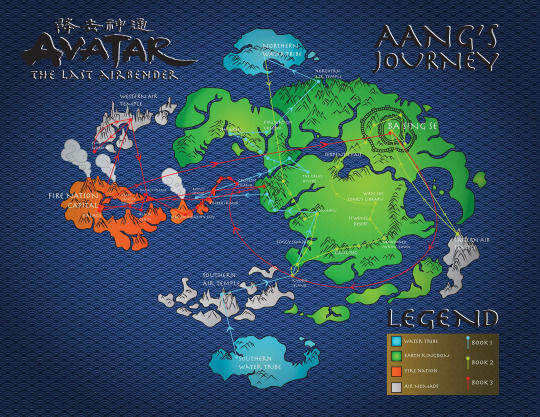
Ba Sing Se's aesthetic is based off of the later years of China's Qing Dynasty (1636-1912):
The Cultures of Avatar: The Last Airbender | Cultural Fashion: Ba Sing Se Queues (tumblr.com)
The Cultures of Avatar: The Last Airbender | Cultural Fashion: Zuko's Teashop Outfit (tumblr.com)
The Cultures of Avatar: The Last Airbender | Cultural Fashion: Ba Sing Se Headdresses (tumblr.com)
The Cultures of Avatar: The Last Airbender | Cultural Fashion: The Dai Li (tumblr.com)
The Cultures of Avatar: The Last Airbender | Cultural Fashion: Royal Earthbender Guards (tumblr.com)
Toph's family and background are meant to appear refined and wealthy so their look is based off of the later years of China's opulent Tang Dynasty (618-907):
The Cultures of Avatar: The Last Airbender | Cultural Fashion: Toph’s Fancy Dress (tumblr.com)
The Cultures of Avatar: The Last Airbender | Cultural Fashion: Toph’s Sleepwear (tumblr.com)
The Cultures of Avatar: The Last Airbender | Cultural Fashion: Toph’s Hairstyle (tumblr.com)
Bumi likes to wear Chinese opera clothing and his character is broadly inspired by Lu Bu of the Three Kingdoms Period (220-280):
The Cultures of Avatar: The Last Airbender | Cultural Fashion: Bumi (tumblr.com)
Kyoshi Island is Heian & Edo period Japan mixed with Ainu culture:
The Cultures of Avatar: The Last Airbender | Cultural Fashion: Kyoshi Headbands (tumblr.com)
The Cultures of Avatar: The Last Airbender | Cultural Fashion: Kyoshi Makeup (tumblr.com)
The Cultures of Avatar: The Last Airbender | Cultural Fashion: Kyoshi’s Hair & Clothes (tumblr.com)
The Cultures of Avatar: The Last Airbender | Cultural Fashion: Kyoshi Warriors Uniform (tumblr.com)
The Cultures of Avatar: The Last Airbender | Cultural Fashion: Kyoshi Islanders Fashion Pt. 1 -... (tumblr.com)
The Cultures of Avatar: The Last Airbender | Cultural Fashion: Kyoshi Islanders Fashion Pt. 2 -... (tumblr.com)
When Zuko and Iroh are on the run in the EK, they encounter a Vietnamese town and a Korean village:
The Cultures of Avatar: The Last Airbender | Cultural Anatomy: “The Swamp” Episode (tumblr.com)
The Cultures of Avatar: The Last Airbender | Cultural Architecture: Song’s Village (tumblr.com)
The tribes of the Si Wong Desert are North African crossed with Mongolian:
The Cultures of Avatar: The Last Airbender | Cultural Fashion: Sandbenders (tumblr.com)
Chong and Lily (Secret Tunnel Hippies) wear Tibetan and Hmong clothing, respectively:
The Cultures of Avatar: The Last Airbender | Cultural Fashion: Chong (tumblr.com)
The Cultures of Avatar: The Last Airbender | Cultural Fashion: Lily (tumblr.com)
The refugee family with the pregnant wife is inspired by Yi people:
The Cultures of Avatar: The Last Airbender | Cultural Fashion: Serpent’s Pass Refugees Pt. 1 (tumblr.com)
The Cultures of Avatar: The Last Airbender | Cultural Fashion: Serpent’s Pass Refugees Pt. 2 (tumblr.com)
And, with the exception of culturally isolated areas like Ba Sing Se/Si Wong Desert/Omashu/Kyoshi/Foggy Swamp, most men in the EK wear their hair in Taoist topknots:
The Cultures of Avatar: The Last Airbender | Cultural Fashion: Earth Kingdom Top Knots (tumblr.com)
So the sort of clothing your characters will be wearing in the EK depends on where in the country they are or are from. If you plan on inventing a new setting that takes place in the Earth Kingdom, try to choose a culture and period that reflects the mood or theme you're trying to get across.
520 notes
·
View notes
Note
I’m late •_• 𝗴𝗶𝗻 𝗿𝗶𝗰𝗸𝗲𝘆 〜. Blue Hawaii ~ and Mai tai ~ for Bai, Ming and Shui please :3
Hehehehe I can always count on you for asks and I love that 💜 I did answer Blue Hawaii for the bros already so you can read that here!
Gin Rickey-What does your Oc consider their best feature? Alternatively, what's something they're the most self conscious about?
Blue Hawaii-Does your oc speak other languages? Too lazy to write the rest
Mai Tai-Ocs life growing up? Same thing here
Shui
Gin Rickey
I think Shui considers her scales when in Koi Form her best feature appearance wise!:} Their shine is quite pretty after all and the pattern is one of a kind!
Her as person wise she will always say her confidence is one of her best qualities, it's key afterall! If you believe you can do it then you can do it.
As for her worst? It's gotta be her scars, yes she wears most with pride but some just serve as a bitter reminder of the times she was too weak.
Blue Hawaii
I imagine the Koi clan has a special kind of Language they use to communicate when underwater that is traditional to them, perhaps some kind of sign Language or based on bubbles that they blow beneath the waves.
Other than Chinese being her mother tongue she also speaks French! She learned it from Arthur and it came in handy as they visit his sister back in france fairly often!^^
Mai Tai
Tw for child abuse
Shui grew up to become a war machine.
Her childhood was filled with harsh military type physically and mental training that broke her down and built her back up bit by bit.
And any disobedience was met with harsh punishments.
She knew little freedom which is why she ran away in her teen years,eventually living along celestials as a soldier and at that point she lived like an adult. It was still suffocating and not easy by any means, but it was an improvement.
Just putting in a Tw for Angst, going hard with it for the bros.
Ming
Gin Rickey
Ming takes a lot of pride in his skills as a doctor, his father taught him after all and he was amazing, so he calls his medical knowledge and how he behaves on the job his best quality.
Other than that he cabt really pride in anything else about himself, Ming has very deep rooted self hatred to him everything about him is a flaw so he can tell you all about his worst qualities, but he won't as he wouldn't admit to his issues even at gun point-
Mai Tai
Mings childhood was fine at first, he had a family he loved, a village he helped care for, the world was this big place full of wonder right at his finger tips, ready to explore.
but then that was taken from him.
Suddenly he had to grow up, take care of his brother and once taken in by the great monk he had to look after everyone, be the emotional core that kept them all happy and functioning.
And then he died before he was ever an adult.
Baí
Gin Rickey
Baí used to say his strength was his best quality, then it became a curse. Then his face was his best quality, he was quite handsome afterall, but then he got that unsightly scar. Now? He can sew, it's one of the few remnants of an identity he is still allowed to have, it's a reminder of his mother, a seamstress.
So yea fashion and clothes making are the best things he's gonna offer.
Mai Tai
Baí had the sane things as Ming and god he wushes he still had them, in their village they ADORED him for his strength, he helped built this home with his own hands, he soiled them in demon blood to protect the ashes that were left of it..
After that wherever he went he was seen as a monster,his brother was the only reason he was allowed to stay a kid a little bit longer, being under the care of the great monk only did so much, sure the pilgrims learned to love him but it came to late.
The damage had already been done so when the one person who never was ill to him was gone a small part of himself died with Ming that day, including what was left of his childhood.
#lego monkie kid#doppel answers#lmk#lmk oc#oc#lego monkie kid ocs#lego monkie kid oc#orignal character#original characters#monkie kid oc#lego monkie kid fandom#monkie kid fandom#oc ask#shui liu#gāuguí ming#gāuguí baí
15 notes
·
View notes
Text
Youngest Original ~ TVDU
Mikaelson!OC
Masterlist
Character profile
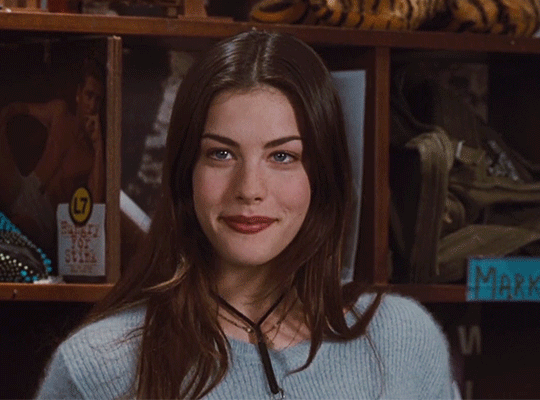
Face claim: Liv Tyler
Name: Kassandra
Name meaning/origin: comes from the Greek language, it means "the one who excels over men"
Date of birth: October 983 A.D.
Date of death: November 1001 A.D.
Age: has been 18 for 1009 years as of 2010
Zodiac sign: Libra (♎︎)
Place of birth: in a village now known as Mystic Falls, USA
Parents: Esther and Mikael
Siblings: Freya, Finn, Elijah, Klaus, Kol, Rebekah and Henrik
Height: 174 cm (5'8 ft)
Eye color: blue
Hair color: Brown
She is a member of the Mikaelson family and is one of the seven Original vampires alongside her father and siblings.
She was the second youngest child, only older than Henrik who was 13 at the time of his death in 1001. His death was the catalyst for the creation of the vampire race.
Can speak many different languages including English, French, Italian, Spanish, Russian, Turkish, Arabic, German, Japanese, Mandarin Chinese, and Korean; can also speak Latin and of course, Old Futhark - her native language
Has a love for music. Even as a human, she had a penchant for singing and dancing. Has written many songs and compositions throughout her life.
Can play 7 musical instruments: the guitar, the piano, the violin, the flute, the harp, the violoncello, and the Guzheng - the Chinese zither
Alongside Elijah, she is the peacemaker of the family, always striving for peace and love. Hates being in the crossfires of her siblings’ disputes.
Baby of the family. All of her siblings are extremely protective of her. Has baby sister privileges (esp with Klaus)
Loves reading. Can often be found reading side by side next to Elijah.
In true Libra fashion hates picking sides, so when her siblings fight she tries to maintain her neutrality. That is often difficult when one side is threatening to dagger the other and put them in a casket for a hundred years.
Elijah is her favorite brother though she swears she doesn't have favorites.
Bonds with Klaus by spending time with him while he's painting in his studio. She's pretty good at art herself, though she prefers pencil drawings and water-based painting. She never got the hang of oil paintings like Klaus did.
She and Bekah are really close and they always have each other's back. They looove spending Klaus and Elijah's money lol
She sometimes wonders how Kol is older than her, cause she is more mature than him. He likes teasing her to get a reaction out of her.
He got choked several times for crossing the line
Just wants everyone to get along lol
#the vampire diaries#original vampire#vampire diaries#the originals#the mikaelsons#mikaelson family#elijah mikaelson#finn mikaelson#freya mikaelson#klaus mikaelson#rebekah mikaelson#kol mikaelson#kassandra mikaelson#mystic falls#headcanon#my original characters#my oc stuff#fem oc#liv tyler#tvdu#tvd universe#tvd fanfiction#the originals fanfiction#my headcanons#libra
34 notes
·
View notes
Text
Miraculous Tales: Meiling (Marinette)
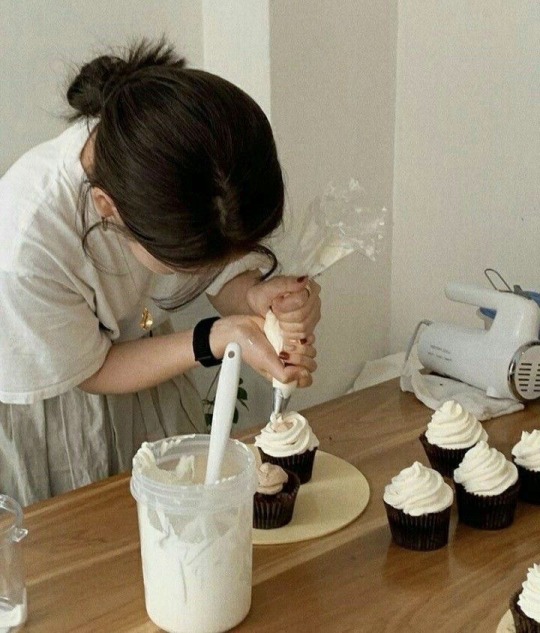


APPEARANCE
Meiling is a slim teenage girl of average height who looks like a perfect combination of her parents, inheriting her mother’s softer features and black while also inheriting her father warm beige skin tone and equally warm brown eyes.
HAIRSTYLES
Meiling tends to wear her hair in simple yet cute hairstyles, like pigtails and twin braids. Most of her hair accessories are light pink bows with the occasional hairclips and headbands.
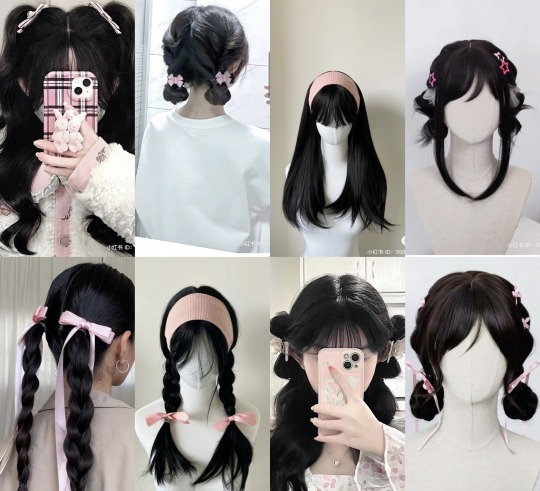
LOOKBOOK
Meiling's clothes are very feminine-coded but also very eclectic, given that most of them were outfits that she herself created since she first learned fashion design. She has a very cute vibe to her outfits that follows aesthetics like soft girl, colorful streerwear, and Chinese streetwear.
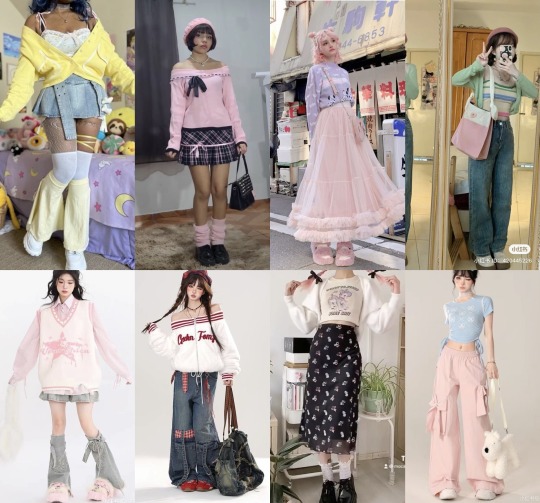
BACKSTORY
Meiling Cheng is a French-Chinese girl who has lived in Jiangxi, China up until the last year when she moved to Paris and live with her maternal grandparents, uncle, and cousin Yumei. The main reasons that she moved to Paris were to further pursue her love for fashion and because her parents believed that she has potential that their countryside village can’t really offer her.
During her first year at Lycée Françoise Dupont, she was already shy to begin with and being the new student who just moved from a remote village in China didn’t exactly help her settle her nerves. Thankfully, her new classmates were pretty supportive and helped her adjust to her new life as a Parisian.
One classmate, however, didn’t take the same approach as the others. Colette Bourgeois, the Mayor’s daughter and one of the most fashion forward students in Dupont.
Now at first, Colette was pretty nice to Meiling, recognizing her a fellow fashion lover and an aspiring fashion designer. However, as the school year went on, Colette started to lose her spot as top student and most fashionable to Meiling. By the end of it, Colette and Meiling became rivals and enemies (think Galinda and Elphaba’s starting relationship) where Chloé would use her money and status to pull pranks on Meiling.
PERSONALITY
Meiling is a spunky, bright, and outgoing young girl. But that wasn't always the chance. During her first year in Paris, she was much more shy and reserved as she knew no one there. It was thanks to her new friends, she was able to open up much more. Meiling is someone who is always willing to lend a helping hand, whether it be helping her classmates with struggling subjects or helping her uncle with his private chef jobs.
She still struggles with self-confidence, often times quick to panic and becomes more clumsy and nervous when she's all over the place. Thankfully, having Tikki as additional support helped her remain much calmer when dealing with stressful situations and standing up for herself against those like Colette.
LADY LUCK



Being the newest holder of the Ladybug Miraculous, Meiling has become Lady Luck, one of Paris' newest superheroes.
APPEARANCE
As Lady Luck, her black hair becomes more blue with her warm brown eyes are now a bright blue, now resembling eyes of a bug. After accepting her role as a superhero, her simple spandex-like outfit changed into one that resembles a red traditional Chinese qipao donned in ladybug spots plus black pants. Her hair is styles in twin buns, each with a long, red ribbon that give off the impression of twin antennas.
PERSONALITY
As Lady Luck, Meiling's personality does a total 180. She's much more calm and level-headed with how she approaches things. To her, the biggest focus when dealing with Pergue is to stop the villain and make sure there is very little damage as possible, building and civilian wise. She wants to be sure that no one is seriously hurt by the Pergue attacks, seeing how bad the damage they often leave behind without remorse.
She is much more responsible and put together as Lady Luck, especially with her interaction with the police, who she shares a very neutral relationship. This is mainly due to how seriously she takes her role as Lady Luck, leading her to sometimes scold the others for being too laid-back while on the job.
But deep down, there is a part of Lady Luck that is wondering if she's really up for the role she accepted. She worries if what her and her team have been doing is actually making an effort and not just delaying the inevitable.
Tagging - @adrianasunderworld @the-weirdos-mind @liviavanrouge @yumeko2sevilla @yukii0nna @queen-of-twisted @abyssthing198 @fair-night-starry-tears @mangacupcake @reawakened-goddess @horrmantic @ice-cweam-sod4 @tragedytells-tales @kousaka-ayumu @achy-boo
#heiress' redesign center#miraculous tales of ladybug and chat noir#miraculous tales#miraculous ladybug#marinette dupain cheng#miraculous marinette#meling cheng
16 notes
·
View notes
Text
𝑎𝑏𝑜𝑢𝑡 𝑚𝑒 ♡꒰ᵕ༚ᵕ⑅꒱

꒰ 𝑖𝑛𝑡𝑟𝑜: i go by nana, i use they/them pronouns and i’m bisexual ♡ in terms of gender identity, i identify as genderqueer.
aquarius sun, capricorn moon and leo rising. turning 18 in less than 2 weeks!
i’m an intp-t, atheist, feminist (trans inclusive) and leftist.
i have a cherub tattoo on my forearm :) i got it done at a motorcycle concentration ദ്ദി ˉ͈̀꒳ˉ͈́ )✧
although i do keep up a personal weight tracking post, this is no longer an 3d blog. i do not want to expose outside people to such an unhealthy lifestyle. if you’re currently in recovery, i wish you the absolute best ♡
꒰ 𝑑𝑛𝑖: p3dophiles and ddlg accounts run by men, conservative/right wing propaganda, which includes white supremacy propaganda, homophobia, transphobia, racism, misogyny or any form of hatred. i’m fine with (body) horror and gore to a certain extent, as well as nsfw and mental health vent accounts. f4tspo or fatshaming isn’t allowed, either.
꒰ my pinterest ꒱
꒰ how to stay occupied ꒱♡꒰ low cal meals ꒱
꒰ 𝑡𝘩𝑖𝑛𝑔𝑠 𝑖 𝑙𝑖𝑘𝑒: super sonico figurines, vanilla, peach, cinnamon or strawberry scented candles, big dogs, stuffed animals, hair accessories, side swept bangs, pyjamas, antiques, queer media, tawog, pink hair, hydrangeas, pink sparkly nails, car rides, hand holding, pastel colors (my faves are #c3d4e7 and most shades of light pink), late autumn and winter, dove products, fragrances/perfume, lip balm, sol de janeiro ‘71.
i loveee butch and masc lesbians sm, and that’s my taste in women basically ♡
i’m a long time fan of sanrio and my favorite character is pompompurin ૮ - ﻌ - აᶻ 𝗓 𐰁
꒰ 𝑖𝑛𝑡𝑒𝑟𝑒𝑠𝑡𝑠: gaming, music, psychology, sociology and history (art, political, fashion, morbid), photography, crafting (clay), baking, writing, organizing things, beauty/self care and fashion (rococo and victorian, vintage, gothic, lolita, jojifuku, coquette/dollette, mori kei, winter clothing), shopping (mostly looking at whatever’s on sale and debating whether i should buy it or not. rarely ever give in).
my absolute favorite youtube channel is kubz scouts (been a fan of jay for years :D)
꒰ 𝑓𝑎𝑣𝑜𝑟𝑖𝑡𝑒 𝑓𝑜𝑜𝑑𝑠: my homemade tomato and tuna cream pasta, cereal bars, flan pudding, sweet strawberries and cherries, chocolate and almond éclair, s’mores, chocolate cookies, warm milk with honey, pain au chocolat, chocolate, milka choco wafer, kfc’s strawberry milkshake and o’cheddar burger, cinnamon rolls, chai latte.
i’m also a fan of portuguese, italian and chinese cuisine.
꒰ 𝑚𝑢𝑠𝑖𝑐: mostly radiohead, lana del rey, deftones, dazey and the scouts, she wants revenge, megan thee stallion, nicole dollanganger, hole, fiona apple, jack off jill, elliott smith, the cure, jeff buckley, lalleshwari, kali uchis, mars argo, chet baker, icp, msi, poison girl friend, tommy february6, petal, mitski, system of a down, slipknot, korn, type o negative, doors, frank sinatra, billie marten, mazzy star.
꒰ 𝑔𝑎𝑚𝑒𝑠: nintendogs, mysims (nintendo ds/3ds), mouthwashing, schoolgirl supervisor, needy streamer overload, genshin impact (tartaglia and kazuha main, ar59), animal crossing: pocket camp (going strong for over 6 years! frett and daisy are my favorite villagers), class of ‘09, ddlc, fnaf sl, dead plate and cold front, re7 and village, outlast, chilla’s art and puppet combo games. anything indie horror, survival, choice.
꒰ 𝑚𝑜𝑣𝑖𝑒𝑠: girl interrupted, brokeback mountain, but i’m a cheerleader, donnie darko, buffalo ‘66, fight club, the basketball diaries, stay (2005), nightcrawler. basically any movie where jake gyllenhaal takes on a leading role ( ˘͈ ᵕ ˘͈♡)
꒰ 𝑎𝑛𝑖𝑚𝑎𝑛𝑔𝑎: banana fish, bloom into you, kase-san and morning glories, mob psycho 100, devilman crybaby, moriarty the patriot, bungou stray dogs, tokyo revengers (i♡ senju and kazutora a lottt, and i wish shion could’ve been more relevant), junji ito manga, classmates/doukyusei, brutal satsujin, boy meets maria, the summer hikaru died. my favorite genre is girls’ love.
𝑡𝘩𝑎𝑛𝑘 𝑦𝑜𝑢 𝑓𝑜𝑟 𝑟𝑒𝑎𝑑𝑖𝑛𝑔
#this is a girlblog#girlblog aesthetic#girlblogging#this is a boyblog#boy blogger#boyblogging#intro post#blog intro#wonyoungism#lana del rey#coquette#coquette aesthetic#faunlet#faunlet subculture
7 notes
·
View notes
Text
In Boat Quay, bronze statues fashioned by Aw Tee Hong in 2003 encapsulate an antiquated routine for merchants and laborers of early Singapore. These statues depict a Chinese trader, a Malay chief, a famous merchant Alexander Laurie Johnston, and men loading sacks onto a cart. The sculptures are located along the river and the former site of Johnston’s warehouse. Johnston, a prominent Scottish businessman and merchant, is seen mediating with the Chinese trader and Malay chief. Hong captures and highlights the multiculturalism integral to Singapore’s identity, showing how diverse the trading community is. Adjacent to these men, a homage is paid to the low-wage laborers of the time. These men, often of Chinese or Indian origin, were vital in traversing the trade routes along the river. As Johnston was one of the earliest British settlers in Singapore, he was among the first magistrates appointed by Sir Stamford Raffles. Serving as one of the Trustees of the Singapore Institution, Johnston established A. L. Johnston & Co. in 1820, making his mark as an active member of the mercantile community. The Scotsman became a founding member of Singapore’s Chamber of Commerce in 1837, helping the nation become one of the most important trading hubs in the world. The artist behind these statues, Aw Tee Hong, was a prominent Singaporean artist known for his paintings and sculptures. He immortalizes Singapore’s heritage, focusing on the country’s humble beginnings as a fishing village and its evolution into a modern metropolis.
11 notes
·
View notes
Text

Feibo Girl
Shanghai, China
For much of China, the phrase “Roaring Twenties” may have a less jovial meaning. While the U.S. is in the middle of its Jazz Age, China is in the middle of its Warlord Era. The end of the Qing Dynasty has seen China is split into waring fractions called cliques, with those living in the country suffering the worst violence. It’s an especially dangerous time to be a woman.
Fortunately, the Fa family lives in Shanghai, where the wars usually aren’t as close, and women’s rights are blossoming. Heavy with Western influence, the neon-lit city is “the cosmopolitan Paris of the East.” It’s an even blend of old and new. Ancient-looking ships sail past modern skyscrapers, and pedestrians push wooden carts next to buses and trollies. [Link] It’s a good thing the women of Shanghai have more opportunities, because the warlords impose high taxes on their people, and ill veteran Fa Zhou can no longer work. His wife brings in some money sewing trendy qipaos, but it’s not enough to cover necessities and the warlord’s taxes. So Mulan takes it upon herself to save her family from financial ruin.
She first tries getting a job at a cabaret called the Lucky Cricket. Her mother and grandmother help give her the makeover needed to transform Mulan into a winking Feibo Girl—a Chinese flapper. Then, hesitantly, Mulan bobs her hair using a long, sharp family heirloom. But despite her best efforts, Mulan’s clumsiness clashes with the cabaret owner’s inability to listen, resulting in a show that entertains everybody for all the wrong reasons. While the patrons laugh wildly and snark that the performer is “on fire,” the literally inflamed owner loudly fires Mulan.
Ashamed, Mulan sits in the family’s garden, deep in thought. Near an opened window, Grandma belts out to American jazz on the radio. Grandma’s dance session is interrupted by an announcement from Dr. Sun Yat-Sen, a political and military leader seeking to reunite China and put an end to the warlords. He is recruiting soldiers for what he calls “the Northern Expedition.” Mulan—athletic, strategic, crafty, and often mistaken for a boy—perks at the announcement.
Ling, Yao, and Chien Po giggle behind their fans as Zongchang boasts of his supposedly enormous masculinity. Meanwhile, Mulan and Shang quietly move to free the captured Dr. Sun Yat-Sen. Along the way, they rescue another prisoner, from Zongchang’s kitchen; the Dog Meat General’s name has several possible meanings, but he does indeed enjoy certain canine dishes. Mulan saves an energetic pup from the butcher, and names him Little Brother. Though not the brightest pooch in the word, Little Brother sniffs out Sun Yat-Sen’s holding cell.
Since Mulan has already been bobbing her hair and binding her breasts per Western flapper fashion, all she really needs is a fake name. She enlists in the National Revolution Army under the alias “Ping.” Joining her are a tiny dragon sent by her ancestors, and the mascot from the Lucky Cricket. Training with both swords and machine guns, “Ping” initially causes some mayhem (thanks in no small part to pranks from her comrades). But by the time the troop boards the train out to their first battle, Ping is one of the most promising recruits Captain Li Shang has ever seen.
Control of the railways is crucial to the warlords’ power, and most battles are fought near tracks. While squeezed onto the train and speeding through the country, the soldiers’ songs about girls worth fighting for are punctuated with harrowing scenes of massacred villages. They pull to a stop at a town that’s been burned to the ground, where Li Shang’s father lies among the dead. This is not the work of just any warlord. This was the infamous “Dog-Meat General,” Zhang Zongchang. A particularly ruthless and incompetent ruler, Zongchang is the most feared of China’s warlords. Mulan’s ingenuity leads to the troop’s first major victory, when she creates an avalanche that buries Dog-Meat’s most important railroad—with most of his troops still onboard.
While in the infirmary, Mulan’s true sex is revealed. At first, Shang and the other men don’t know how to feel. But it turns out that a woman may be exactly what they need in their next move against Zongchang. The Dog-Meat General has a harem of 30-50 women, who are assigned numbers because he can’t remember their names. And he forgets their numbers. The guy is just asking for this infiltration. Mulan’s experience at the Lucky Cricket cabaret is now inviable. She drills the men on how to dress and act like attractive ladies, and the operation is soon underway.
Back at the harem, it’s time for the next phase of the plan. This requires the drag-queens to take out some guards, which means another distraction is needed. Luckily, the Dog-Meat General also fancies himself a poet. Mushu and the cricket take over the job of distracting him, by claiming to be his new typists. Cri-Kee hops from ink to paper, taking down what the Dog Meat General dictates, while Mushu observes. The finished poem reads:
You tell me to do this,
"Poem about bastards" by Zhang Zongchang[b]
He tells me to do that.
You're all bastards,
Go fuck your mother.
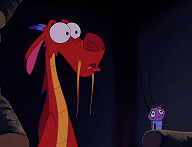
Instead of applause, this poem is followed by an explosion of fireworks detonating all around his military base. Mulan has finally destroyed Zongchang’s army beyond salvaging. The Dog-Meat General himself is killed by an officer avenging his father; Li Shang blows his smoking pistol with satisfaction. Shang follows Mulan back to Shanghai, where they begin a new life together in a unified China.
AN: This picture came out looking very similar to the design that Jacquelynn Harris gave Mulan in her Disney flapper series. I assume this is because we both based the outfit on Mulan’s matchmaker attire, and her hair on actress Anna May Wong. The background border is clipart.
On the story: In the old version of my Disney flapper series, I set all the stories in the U.S. Someone suggested that I look at non-Western fashion from the era, and I dismissed the idea, ignorantly assuming that the Roaring Twenties only happened in the West. This time around, I decided to check if anything interesting was happening in China in the 1920s…and wow, what a rabbit hole! So many things fit so perfectly with Disney’s version of Mulan, especially with that bizarre Zongchang character. I’d never personally create an Asian villain with “dog meat” in his name, but the Dog-Meat General is one of those “can’t make this sh-t up” historical figures. Of course I took liberties with how the history actually played out, as Disney often does; but all of the personal traits described, from the numbered harem to the literal dog meat to that poem, were real. And yes, he was killed by an officer avenging a relative.
To anyone so inclined, here are a couple of incredible time-capsul videos from China in around this time period.
Up the Wangpoo River to Shanghai (1920s)
A video with sound and color from 1929
#prohibition princesses#disney flappers#fa mulan#mulan#1920s#roaring twenties#feibo girl#flapper#china#chinese#chinese new year#qipao#cheongsam#sun yat sen#zhang zongchang#dog-meat general#chinese history#disney princess#digital art#fan art#art#roaring twenties au#feather boa#dragon#year of the dragon#shanghai#cabaret#warlord era#warlord#asia
19 notes
·
View notes